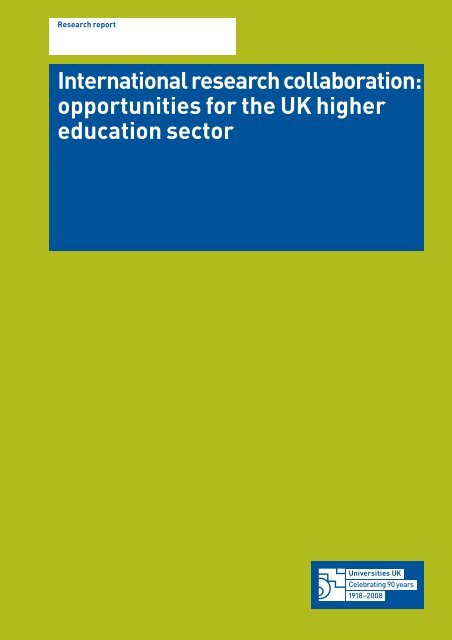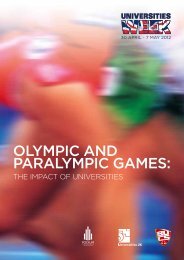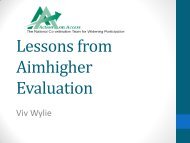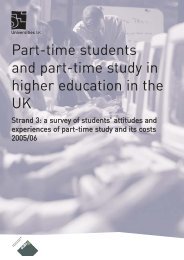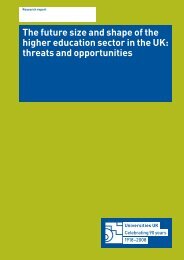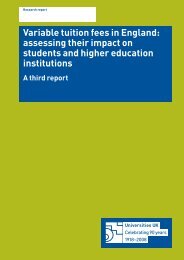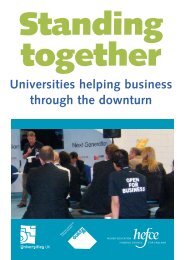International Research Collaboration - GlobalHigherEd
International Research Collaboration - GlobalHigherEd
International Research Collaboration - GlobalHigherEd
You also want an ePaper? Increase the reach of your titles
YUMPU automatically turns print PDFs into web optimized ePapers that Google loves.
<strong>Research</strong> report<strong>International</strong> research collaboration:opportunities for the UK highereducation sector
2The studyThis study of international researchcollaboration has involved a mixture of deskresearch, survey and interviews in order to arriveat an overview of:p the trends and benefits of internationalresearch collaboration;p the national policies and support forinternational research collaboration inselected UK competitor countries, with aparticular focus on support for universities;andp UK universities’ management andorganisation of international researchcollaboration.Universities UK <strong>International</strong> research collaboration 5
3Trends and benefits of international researchcollaboration3.1 Extent of collaborationThere is a small but growing body of statisticaland empirical material that tackles the questionof UK university involvement in internationalresearch collaboration, in terms of its nature,extent and trends. The report by EvidenceLimited, is arguably the most comprehensiverecent analysis 1 . There is a much larger body ofwork that debates the motives and benefits ofinternational research collaboration, available atboth the national and supra-national levels 2 .The literature reports strong growth ininternational research collaboration and theexpectation that this will continue into the futureand might very well strengthen. Most reportspoint to supporting trends in one or more of theprincipal indicators, which include the number ofp international research outputs;p international patents;p international research awards (and theirvalue); andp non-national researchers and researchstudentsThe first of these indicators – using bibliometricdata – has proved to be perhaps the most fruitfulin helping to map the development ofinternational relationships in a systematicmanner, capturing important aggregateexchanges among the research communities ofdifferent countries and tracking the ebb and flowof this international endeavour 3 .Bibliometric statistics suggest that the numberof UK international journal articles is growing atperhaps 5 per cent a year, as compared withtotal research output, which is growing at 2–3per cent a year. The same data show that thisclass of research papers has seen its share oftotal UK research outputs rise from around 30per cent in the 1990s to around 40 per cent (in2005), a trend that is replicated broadly speakingfor France and Germany and far outstrips Japanand the United States.Table 1 presents three related tables showingrecently compiled figures for the numbers ofinternational research articles published in eachof the last two, five-year periods 4 . The first twotables present the basic counts for each period.The third table presents growth across the twoperiods. The first two tables show the counts forthe UK and a series of eight partner countriesand a residual figure for papers written withauthors based at addresses somewhere in therest of the world (ROW), which together add up tothe total number of international papersrecorded by the Thomson ISI web of sciencedatabase. For comparison, the first two tablespresent the counts of international researchoutputs for each UK partner country in turn,along with the distribution of output across theother partner countries (and the UK) 5 .6
90,00080,00070,00060,00050,00040,00030,00020,00010,0000The data suggest that the UK’s most prolificinternational partnerships are with researchers inthe United States, Germany and France, whichtogether account for around 55 per cent of its totalinternational research output as captured by theThomson ISI database. These same data suggestthat the UK’s fastest growing internationalpartnerships are with researchers in China, wherethere has been a doubling in the output ofinternational papers between the 1990s and 2005.<strong>Collaboration</strong>s with researchers in India,Australia, Canada and Germany have all seenstrong growth of between 50 per cent (Germany)and 65 per cent (India) during the same period.Chart 1 takes the same data for each of the tenyears since 1996 and presents them in a linegraph, better to illustrate the trend in UK-Chinaresearch collaboration, which has grown morethan threefold, rising from 400 to 1,600 copublicationsa year, and the rate of growth isaccelerating. The chart also presents the ISIdatabase counts for all UK articles and for allChina articles, the latter of which show a fourfoldincrease, albeit from a low base, as compared withan increase of about 20 per cent for the UK. Thevery similar growth trend for China articles andUK-China articles suggests that the rapid growthin international research collaboration with Chinais being driven, or facilitated at least, by anexpansion in the capacity and output of theChinese research system more generally. Thereare other indicators which might support thisnotion: China has seen an increase in its share ofworld scientific publications, from 2 per cent to 6.5per cent over ten years (1995–2004); and itsspending on research and development hasincreased by more than 20 per cent a year since1999. It stood at 1.3 per cent of GDP in 2005 6 .Chart 1Growth of researchcollaboration between theUK and China1996 1997 1998 19992000 2001 2002 2003 2004 2005180016001400120010008006004002000UK-China research collaboration has becomemuch more significant in the past decade and isstrengthening. However, some degree of cautionis necessary when drawing conclusions fromthis bilateral analysis: more detailed data showthat most of our partner countries have seen anincrease of more than 50 per cent in theirinternational collaborative output, and adoubling at least of links with China. Australia,the United States and Japan have seen thestrongest growth in output, while the UK andGermany have seen the least growth.UK research collaboration with ChinaInnovation China-UK (ICUK) is a multi-millionpound research partnership between the UK andChina, co-funded by the UK and Chinesegovernments in a bid to bring the latest jointresearch to the marketplace. In May 2006, theproject was awarded funding of £5 million fromthe UK’s Higher Education Innovation Fund(HEIF3), which is to be matched by the Chinese(the first time a research initiative on this scalehas been jointly funded by the UK and China).Queen Mary's University of London is taking thelead, working with four other UK universities(University of Nottingham, King’s CollegeLondon, Royal Veterinary College, University ofSouthampton) in cooperation with around 20Chinese institutions 7 .The Supergen group was awarded £202,258through the Engineering and Physical Sciences<strong>Research</strong> Council (EPSRC) INTERACT scheme(4th Call) to link its funded projects with similaractivities in China. The aim is to extend theinternational influence of this flagshipsustainable energy programme to China, and topromote or augment individual members’overseas research links. The two-year projectincludes group visits, workshops, exchangevisits and the establishment of a forum. TheInteract Supergen Group involves collaborationbetween seven UK and seven Chinese highereducation institutions 8 .UK China UK-ChinaSource: Table 1 of <strong>Research</strong> in China: patterns of internationalcollaboration, FCO, Beijing, January 2007, based on Thomson ISIpublications data8
3.3 Motives and benefitsThe desk research and surveys make clear thefact that the benefits of and motives behindinternational research collaboration looksomewhat different depending upon one’sperspective, and level within the researchsystem: national, institutional or researcher.The world’s politicians and policymakers arebroadly in agreement with one another aboutnational policy ambitions, with mostinternational research strategies citing the samequartet of motives, which are:p maintaining and enhancing thecompetitiveness and sustainability of thedomestic research system facilitated byresearch institutions becoming moreinternational. This includes establishing newstrategic partnerships to boost researchquality and reputation, improving access tointernational labour markets (researchersand research students) and achieving theeconomies that can result from sharing thecost of overheads;p improving the competitiveness of thedomestic economy, secured throughresearch-led access to overseas markets andby the attraction of high-value added inwardinvestment;p a commitment to expand the global assault onthe most pressing, shared problems, such asclimate change, poverty and security; andp a commitment to the internationalisation ofpeople and politics, with researchcollaborations and researcher mobility seenas being a powerful and cost-effectivecontribution to a more harmonious and saferworld (global citizens).Selection criteria for partner countries andthematic priorities are closely related to theseobjectives. They encompass scientific, politicaland economic considerations and areincreasingly applied based on systematicinformation gathering on science and technologyresearch activity in other countries.A survey of EU member states’ senior scienceand technology officials (carried out on behalf ofthe CREST working group on internationalisationof research and development) confirmed thesepriority objectives. It underlined the extent towhich domestic wealth creation is the strongestof three major objectives: 60 per cent ofrespondents stated that gaining access toemerging markets was a primary motive.Interestingly, at this national or strategic level,increasing the quality of research was reportedto be a primary focus for just under half of allrespondents, an outcome that underlines theimportance of research to wider economicambitions and international relations moregenerally.Exhibit 1Major objectives ofinternationalisation ofscience and technology inEU member states (n = 20)Tackle global issues andinternational developmentIncrease the quality of R&DImprove competitivenessand market access0% 10% 20% 30% 40% 50% 60% 70%Source: Survey of EU member states’ senior science and technologyofficials carried out on behalf of the CREST working group oninternationalisation of research and development, July 2007These national-level drivers echo the motives ofUK universities to some extent, with mostexpressing concern about the long-termsustainability of their institution in what is seen tobe an increasingly global market place, especiallyfor the provision of postgraduate education andthe recruitment of students and staff.“By 2015, our distinctive ability to integrateworld-class research, scholarship andeducation will have secured us a place amongthe top 50 universities in the world.” Visionstatement from the University of Leedscurrent strategy. 13Universities UK<strong>International</strong> research collaboration11
Institutions foresee benefits in a variety ofguises, but perhaps most prominent are: theirinternational standing derived from very visibleand successful research collaborations (forexample, with leading researchers, businessesand institutions; and the influence it can conferwithin international forums and politicaldebates); a good supply of top-flight researchstaff, and a plentiful supply of good researchstudents. Most also see that they have a publicduty, as part of their institutional mission, tosupport knowledge transfer throughinternational collaboration as a route toenhanced social equity and economicdevelopment.Exhibit 2 presents a well-developed list of‘drivers’, which include many of the forces forchange cited by senior officers interviewedduring the course of this study, although in thiscase, the list was specified in a presentation bythe University of Leeds.Exhibit 2Drivers of internationalresearch collaboration(University of Leeds) 14Drivers of the ‘internationalisation’ of researchp World-class research is inherently international and important forthe sustainability of a research-led university;p Undergraduates, research students and postdoctoral researchersincreasingly request international experience as part of their‘standard’ education;p Major corporate funders are changing their purchasing styles (valuefor money, stimulation of developing economies, new forms ofpartnership) favouring international collaborations;p Collaborative research publications gain 2.5 to 5 times the citationimpact of the field average for ‘single-country’ authored papers;p EU programmes facilitate direct involvement of many countries;p Several major non-UK funders (for example the National Institutesof Health in the United States) are increasing the scope of their callsfor proposals, with very significant income being secured by UKuniversities;p UK research funders’ emerging commitment to prioritise researchinvestment around global challenges (for example, the researchcouncils);p Regional economic development agencies across the UK areencouraging local universities to work with them to strengthen theirability to secure international objectives for the region, aroundexports, foreign direct investment and productivity.Source: Presentation by Richard Williams, Pro-vice-chancellor forEnterprise, Knowledge Transfer and <strong>International</strong> Strategy at theUniversity of Leeds, to a Universities UK seminar, London, 20November 2007Exhibit 3Drivers of international research collaboration (University ofBritish Columbia, Canada)Why we pursue international research collaborationsp Different perspectives promote knowledgep Capacity-building without costp <strong>Research</strong> fundingp To develop solutions that resonate around the worldp Graduate student recruitmentp ReputationSource: Presentation by Craig Klafter, Associate Vice President<strong>International</strong>, University of British Columbia, to a Universities UKseminar, London, 20 November 2007As with the national agenda, research excellenceis just one of several objectives for universities,although, once again, as with most aims, it is themeans rather than the end. Global visibility andinstitutional reach appear to be more typical ofthe high-level ambitions of UK universities, andthis is being driven by expectations of studentsand staff, global competition and gatheringforces of institutions, cities, regions andgovernments – all pressing universities toengage with an international agenda and todevelop more operational clarity around this.Two of the drivers mentioned by institutions areless commonly reported in national policydiscussions, and yet they are clearly ofsignificance to researchers themselves. The firstrelates to the insights that can result fromcollaboration between academics with differentepistemic perspectives, wherein attempts toresolve tensions and apparent contradictionscan precipitate the emergence of new ‘truths’and prompt advances in understanding moregenerally 15 .The second novel institutional driver relates tothe occasional need to deliver capacity quicklyand at low or no cost to the university, which canbe achieved through project-specificcollaboration among established partners.These kinds of temporary alliances arecommonplace in many areas of the privatesector, and are expected to be an importantfocus for organisational development in thefuture.Exhibit 3 presents a similar although perhapsrather sharper set of drivers from a Canadianuniversity, underlining the quite generic natureof universities’ goals in the international arena.12
Exhibit 4 presents the results of this survey, withthe measures sorted in descending order usingthe number of citations, which reveals a patternclosely matching the kind of assistance in usehere in the UK. <strong>Research</strong>er mobility schemesand in-country support by embassies are prettywell universal, and support with partner search,technical advice and in-country promotionalcampaigns are also pretty widespread.The ranking reveals two measures where the UKmight be argued to be somewhat out of step withthe majority, which are:p The share (60 per cent) of countries thatresponded to the survey, stating that theymaintain dedicated promotional agencies incountry,in selected strategic partnercountries. The UK is beginning to match thiswith its recently opened <strong>Research</strong> CouncilsUK (RCUK) offices in China, India and theUnited States.p The share (50 per cent) of countries thatresponded to the survey, stating that nationalresearch schemes are able to pay the costs ofnon-national partners involved with ‘national’research projects. The Scandinavian countriesappear to have been particularly forwardlookingin this respect, having beenencouraging international projects withintheir national schemes for at least ten years,and being increasingly prepared to considerextending the geographical application oftheir financial investment (through nationalinstitutions) to secure engagement withstrategic partners.Our own discussions confirm that mostcountries’ embassies are involved actively inmonitoring and reporting on important scienceand technology developments, brokering andhosting inbound missions and the organisationof ad hoc bilateral conferences/events. Embassysupport for business appears to be moredeveloped than support for universities, on theassumption that the university sector has its ownliaison offices. There is also activity at the level ofthe research institutes, with some universitiesand institutes having decided that it makesstrategic sense for them to create affiliates ofnational universities and research institutes inanother country. We heard from our interviews inChina that American universities wereparticularly active in this regard.Exhibit 4<strong>International</strong> researchcollaboration measuresacross EU member states(n = 20)Measure Number percentageof countries of countriesSmall grants for overseas visits 19 95%Promotion in country by embassies 18 90%Support with partner search 17 85%Unfunded foreign partners in national projects 16 80%Technical advice to individual collaborators 16 80%Nationally coordinated internationalmarketing campaigns 15 75%Dedicated sponsorship agencies in country 12 60%Joint funding of running costs 12 60%Joint funding of infrastructure 11 55%Local funds for foreign partners innational projects 10 50%Other funding measures 10 50%Foreign branches of research institutions 10 50%Other promotion measures 7 35%Other measures 5 25%Fiscal incentives 4 20%Source: Survey of EU member states’ senior science and technologyofficials carried out on behalf of the CREST working group oninternationalisation of research and development, July 2007Universities UK<strong>International</strong> research collaboration 15
5UK universities’ management and organisation ofinternational research collaboration165.1 Survey and interviewsWe ran an online survey directed to the vicechancellorsand principals of 150 universitiesand higher education colleges, and obtained 86responses. We carried out follow-up interviewswith twenty pro-vice-chancellors and researchdirectors at a wide range of institutions todeepen our understanding.While pro-vice-chancellors were content torespond to our survey, confirming the timelinessand importance of the topic, we found thatrespondents were rather more diffident when itcame to representing their institution as any kindof exemplar. For most, this was an importantjourney that they have only recently embarkedupon.5.2 Policy and strategyThe survey suggests that there is an almostuniversal commitment across UK highereducation institutions to expanding theirinternational research collaboration, withalmost all respondents (94 per cent) confirmingthat it is currently an active aim of theirinstitution to develop such collaboration.Almost all (94 per cent) are actively trying toincrease the volume of research collaboration,with around two-thirds targeting institution-levelcollaboration on specific disciplines andcountries, which in practice means thematicpartnerships with one or more institutions in agiven country.Follow-up interviews revealed an importantdistinction between two classes of internationalresearch collaboration, with most peopledistinguishing institution-level strategicpartnerships from researcher-levelcollaboration. The latter is reported to accountfor the great majority of total activity and isdriven by individuals’ own research interests andambitions, where international engagement isan integral part of being a research professional.Respondents see their duty here as beingfacilitative, for the most part simply providinggeneric support and ad hoc advice to individualsand research groups. For most, this bottom-upapproach increasingly coexists with a morestrategic, institutional perspective. It seems thatmany UK universities already have a smallnumber of strategic research partnerships,institution-to-institution, with overseasuniversities or research groups, motivated by thedesire to sustain or improve the institution’sresearch capability and international standing orreputation. As the University of Birmingham’sinternational strategy comments:“<strong>International</strong>isation in itself isn’t ‘new,’ butwhat is new is the way in which institutions,and now towns, cities and government, areengaging with the international agenda morestrategically and with more operationalclarity.” 18It is also clear that most of these institution-levelrelationships began with educationalprogrammes, ranging from double mastersdegrees to international summer schools andmajor recruitment campaigns. However, there isclearly a growing interest in researchcollaboration, more narrowly:“Launched in April 2005, the strategy of theUniversity of Edinburgh’s China Office is toenhance the University's profile through thedevelopment of research and educationallinks with high-ranking Chinese institutions.Through these links and public awareness ofthe university’s reputation, Edinburgh hasdeveloped a good relationship with variousfellow prestigious universities and academicinstitutions, such as Peking University,Tsinghua University, Fudan University,Beihang University, Beijing Film Academy,Xiamen University, Nankai University, ChinaAgriculture University, in fields as diverse ase-science, engineering, life and medicalsciences, arts and culture” 19 .“Columbia University and the London Schoolof Economics (LSE) have a formalcollaboration at the institutional level, and ourtwo anthropology departments already havean ongoing program for collaboration andexchange. At both the institutional anddepartmental levels, Columbia and the LSEshare a number of areas of expertise andinterest. For example, our anthropologydepartments have substantial shared regionalexpertise in South Asia and East Asia, as wellas expertise on the themes of globalisation,nationalism, and gender. And yet there arealso significant differences between thedepartments and institutions – in approachesto anthropology, in undergraduate andpostgraduate teaching programs, inadministrative framework, and so forth. Weconsider these to be areas that provide scopefor a genuine collaboration between partners,as well as an opportunity to evaluate theeffectiveness of these educational tools in twodistinct and yet closely related learningenvironments” 20 .
“Forging scientific links with othersynchrotrons across the world has been animportant element of Diamond’s work thisyear. During 2006 Diamond Light Source hassigned a number of memoranda ofunderstanding with international facilities. On20 February 2006, during the China-UK N+NWorkshop on Synchrotron Science inShanghai, Diamond signed a memorandum ofunderstanding with the Shanghai SynchrotronRadiation Facility/Shanghai Institute of AppliedPhysics, Chinese Academy of Sciences” 21 .“India is a huge focus for Leeds MetropolitanUniversity and our Northern Film School, andwe have strived to establish strong links to theIndian Film Academy (IIFA) and Bollywood. Ourmotive is a blend of enterprise (3rd stream),education and practice-led research andconsulting. <strong>Research</strong> collaboration is not a bigpart of what we do, however it is an increasinglyimportant part of the mix; we are just about toestablish two academic chairs, the IIFA Chairfor Global Cinema, and an India 60 Chaircelebrating 60 years of Indian independence.The infrastructure, relationships and insightgained through the work with India and the IIFAhas been used as a platform for ongoing effortsto develop a strategic collaboration with SriLanka (Colombo, High Commission, BritishCouncil) around ‘responsible tourism” 22 .There is widespread commitment to becomingmore strategic, which is not to say thatinstitutions are seeking to switch modes frombottom-up to top-down, but rather to do a betterjob of operating a hybrid model. The surveyfound that only a few universities presently havean international research collaboration strategy(13 per cent), although it revealed that asignificant majority has plans to develop such astrategy in the near future (65 per cent). An evengreater proportion (91 per cent) stated that theybelieved their university would benefit frommanaging international research collaborationin a more strategic fashion. Follow-up interviewsrevealed that many of these strategies areinternational strategies and not internationalresearch collaboration strategies per se, anddeal with the internationalisation of the entirespectrum of higher education activities,including research. In many cases, internationalresearch is addressed as both means and ends:research of international significance used as ameans by which to compete with other UK andoverseas higher education institutions for thebest researchers and research students;international collaboration as a means by whichto secure and sustain research capability ofinternational standing.Exhibit 6Institute of Education’sinternationalisationstrategy (2005-2008)Strategic objectives for the Institute’s international workThe overall aim of the strategy is to secure the Institute’s position asa global leader in the field of education and related areas of socialscience and professional practice.Its objectives are as follows:p The generation and dissemination of knowledge that recognises adiversity of contexts and is informed by the Institute’s commitmentto truth and justice;p The promotion of international, intercultural and comparativeapproaches to Institute activity;p The achievement of market leadership in terms of attractingstudents from outside the UK to study education and related areas;p The achievement of a significant increase in the income generatedthrough research and third stream work with an internationalorientation.Source: Extract from the <strong>International</strong> Strategy of the Institute ofEducation at the University of London (2005)A minority said that their international researchcollaboration strategy was being developed aspart of the institution’s wider research strategy.The documents encompass a number of facets,including the institution’s international researchstanding (and monitoring thereof), itsrecruitment of talented researchers, support forshort overseas visits for younger researchers,and the pursuit of international researchcollaborations in areas of particular importanceto the institution.The survey and interviews suggest that overallinstitutions no longer feel that it is quite enoughto leave things to individual researchers and thatthe realisation of their more general institutionalobjectives is more likely if some consciousdecisions are made centrally about the creationof international partnerships in particular fields,and even with specific institutions.Universities UK<strong>International</strong> research collaboration 17
Some interviewees expressed minorreservations as to the ultimate feasibility ofmanaging research collaboration centrally,because of its critical dependence upon bringingtogether individuals with complementaryinterests and ambitions, where deepspecialisation and interpersonal chemistry canrather get in the way. These same intervieweesstated that while senior management mightreadily divine one or two of the more obviousstrategic partnerships, they are not in a positionto look more widely. To help to overcome thisparticular challenge, several of the respondentshad created internal seed funds, which inviteresearch groups to come forward with proposalsfor international projects or networks, which ifsuccessful will be granted £10–20,000 tofacilitate relationship-building and ideally a jointfunding application.We heard one of two arguments against the needfor increased central management andcoordination of international researchcollaboration, including one individual whoexpressed concern at the growing pressureevident in policy circles for universities to bedoing more, which he suggested was somethingakin to a problem looking for a solution. Severalof the more research-intensive universitiesargued that the bottom-up approach really wasthe best way to organise things.“I am not a great fan of institutional strategiesfor, or central management and coordinationof, international research collaborations.Universities need hungry individuals that wantto collaborate with overseas partners, coupledto administrations that support them in theirambitions and do what they can to supportthem. I don’t see much need for ‘strategy’ thatgoes beyond this” 23 .5.3 BenefitsInterviewees told us that there are severalbenefits to a university of being strategic, insome degree at least, about the management ofits international research collaboration:“Intangibles: it increases the reputation andbrand value of the university at home andinternationally; it underwrites thecosmopolitan feel of the university; and itmakes us (students and staff) more aware ofglobal issues and means we are likely to bebetter global citizens.Tangibles: the potential to secure increasedlevels of research and consulting incomeoverall as compared with a bottom-up model;it has the potential to strengthen one’stechnical capabilities through concentrationand specialisation on the one hand and thepooling of complementary (and otherwiseabsent) competences, methodologies anddata sets on the other; the potential toincrease the numbers and quality of nonnationals(fee paying) applying to study firstand higher degrees, including researchdegrees”.Interviewees suggested that this more strategicmode of behaviour falls naturally to theuniversity’s central functions or the faculties anddepartments because an individual researchercannot easily be ‘strategic’. It is equally unlikelythat such behaviour would emerge automaticallyas an aggregate effect of many researchers’individual decisions. They commented:“The institution is better equipped to createsignificant and wide-ranging collaborations,as compared with individual researchers.Moreover, individual researchers oftenstruggle to sustain long-distancerelationships, as their respective careersprogress and their research interests evolve.Individual relationships may wither forpersonal reasons, even when there is still agreat deal of potential value to be derived”.“The NSF Materials <strong>International</strong> Institute forComplex Adaptive Matter, a subsidiary of theInstitute for Complex Adaptive Matter (ICAM)at the University of California, is a multilateralinternational research partnership involvingthe Max Planck Institute and CambridgeUniversity, among others, a collaborated thatis reported to have helped the University ofCalifornia leapfrog from ‘ordinary’ to ‘worldclass’ in this materials field in little more thantwo years”.“The university has the authority, reputationand resources to establish friendships andmutual understandings among a muchbroader group of interested and influentialparties (eg in-country universities andministries, the local British Council, ForeignOffice, etc) as compared with individualresearchers or research groups. Similarly, theinstitution has the financial wherewithal toestablish a significant presence in-country, tobuild relationships and engage local staff, andgenerally embed the institution and its jointventure”.18
5.4 OrganisationWhile there is no single organisational model,the survey and interviews suggest that there issomething of a standard approach beginning toemerge, with a member of the seniormanagement team having overall responsibilityfor policy and strategy and a director and smallteam coordinating the execution of the strategy,but usually in concert with departmental teamsand senior researchers. Often there is aninternational committee comprising externalpeople to provide advice and challenges to theinternal team.Our survey established that for the greatmajority (76 per cent), international researchcollaboration is the specific responsibility of oneof the university’s senior officers, typically a provice-chancellor.However, only around a quarter(27 per cent) of higher education institutionshave personnel in central units who spend atleast half of their time supporting internationalresearch collaboration activities, and just lessthan a quarter (22 per cent) have peopleperforming such roles at the department-level.The interviews refined this view somewhat, andsuggest that, in most cases, the pro-vicechancelloris supported by a small team ofinternational research collaboration staffers. Itseems that most have a senior member of theuniversity staff, at director level, withresponsibility for the delivery of internationalresearch collaboration, whether that is thedevelopment of strategic research partnerships,or the provision of support on demand toindividual research collaborators. However, inmost cases, he or she also has responsibility forseveral other important outward-facingfunctions, such as international studentrecruitment or external relationships moregenerally. Central support teams are similarlyquite likely to have a broader corporate remit, soa team of 5-10 people might very well amount torather less than one full-time equivalentmember of staff dedicated to internationalresearch collaboration.“In terms of our strategic approach theUniversity of Bath’s attitude is that we shouldblend a top down and bottom-up approach. Weshould encourage collaborations to developbottom-up and do what we can to supportthese, but this should be supplemented by amore concerted ‘top-down’ effort in areas thathave been identified as ripe for furtherdevelopment. The research support units inthe university help researchers to find suitablepartners if necessary, and provide the usualrange of other ‘<strong>Research</strong> Office’ activities,such as assistance with funding opportunities,grant applications, etc” 24 .“At the University of Bristol, the pro-vicechancellorfor research (Malcolm Anderson)has overall responsibility. He is heading up theoperational unit that provides internalsupport. The university is also a member ofthe Worldwide Universities Network (WUN) –Vice-Chancellor Eric Thomas is the chair –and this is a key mechanism through which itdevelops and thinks about internationalresearch collaboration at a more strategiclevel. They have an international developmentmanager who leads for them in this area froman operational participation perspective” 25 .“Bi-lateral relationships are quite commonbut multiple partner arrangements are rare.With an increased desire to develop strategicinternational links to address global issuesthere is an opportunity to increase thelikelihood of success by using establishedinternational university networks. Some ofthese networks have already establishedtrusting relationships between their memberinstitutes and the discipline based researchclusters within them. Some can alreadydemonstrate a track record of researchoutcomes. For example, the World UniversityNetwork (www.wun.ac.uk) with its emergingprogramme of research to address globalchallenges is a clear opportunity for UKresearch councils to connect with, especiallywhere the challenge programmes alignstrongly with the thematic signposts in therecent Treasury delivery plans. For example,in the case of EPSRC (they relate) to healthand medical technology, energy,nanotechnology etc. Use of such networks willspeed the rate of progress and seems anobvious first point of call for research councilsseeking to explore effective multi-partnercollaborations” 26 .Universities UK<strong>International</strong> research collaboration 19
“Leeds Metropolitan University’s <strong>International</strong>Faculty works very hard to keep track of theinstitution’s international collaborations. Wework with the individual faculties to keep arecord of all proposals submitted and currentjobs, as well as encouraging visitors – inboundand outbound – to prepare a standard reporton their trip, a ‘database’ of experiences andcontacts which is available for others to referto and learn from. We also try to keep a recordof students, income and publications. As wellas trying to capture information on individualactivities and transactions, each facultyprepares an annual report covering all of itsmany and various international activities,which is then synthesised and reviewed by thesenior management team” 30 .5.7 Critical success factorsJust as there is no single reason for or type ofinternational research collaboration, so it wouldbe hard to imagine a single, right way ofmanaging international collaboration. Indeed,none of our contributors proffered a guide tocollaboration.Notwithstanding this diversity, contributors didpoint to a small number of what one might callrules of thumb which they believe are critical tosuccessful research collaboration:p To be successful, strategic researchpartnerships need to align with an institution’swider research and education strategy, inorder to be sure of senior management’s fullengagement and its ability to invest real timein the relationship.p Most institutions seek to maintain just a few ofthese strategic relationships, five rather thanfifty, whereas the international partnershipsof their individual researchers will run into thehundreds.p There has to be value evident in thecollaboration for all parties, as creating newstrategic partnerships requires a lot of seniormanagement time and energy as well assubstantial investment. The bestcollaborations are non-competitive spaces,where everyone gets something positive out ofthe relationship and mutuality and reciprocityare strong ideas.p Strategic partnerships seem to work bestwhere there is a good fit in terms ofinstitutional goals, competences andphilosophies.p Really successful collaboration tends tounfold over time, and to follow on from earlierrelationships and success.p Supporting success where it emerges fromthe bottom. This includes providing aninstitutional-level commitment, extending thecollaboration through different types ofinteraction and even investment so as toreduce the risk of a partnership waning as aresult of individual researchers’ careermovements.p <strong>Research</strong> collaboration is rather different toeducational partnerships. It depends criticallyon the commitment, chemistry and benefitsderived by a small group, which requiresdifferent sorts of support people to those onefinds in some international units; people whoare a little more proactive and creative, peoplewho will think about the best way to tackle anissue, and not be limited by existinginstruments or bureaucratic procedures.p Where language and cultural differences areparticularly pronounced, it can be a great helpto include one or more post-doctoral fellows,originally from the partner country, in theteam, working closely with the senioracademics.p In terms of institutional support, it seems thatit makes good sense to appoint a senioruniversity officer with explicit responsibilityfor international research cooperation andideally having a collaboration strategy, teamand budget to pursue those duties.p Even within established strategic researchpartnerships, central management teamsfacilitate rather than prescribe and must workin conjunction with senior academics. Theresearchers have to want the partnership tobear fruit.p Several universities report great successarising from the institution having created asmall international fund, for academics/staffto bid into competitively, which encouragespeople to come forward with ideas forcollaboration that might ultimately be ofstrategic interest to the university. The opennature of the competitions has generatedwidespread interest and is proving to be quitea powerful seed fund for future projects andpartnerships.Universities UK<strong>International</strong> research collaboration 21
p Several interviewees stated that they try tomain a central archive of reference material,from listings of country contacts, to checklistsfor travellers and even presentations and visitreports, submitted by previous travellers. Inaddition, some universities maintain a list ofnamed individuals with a lot of experience ofcollaboration with a given country, and whomthey can refer people on to in order to obtain amore personal and in-depth introduction tothe whys and wherefores of collaboration,from etiquette to funding systems.Beyond this, interviewees tell us that successstill has a somewhat random quality:“Success is part chance, part hard work, partgood communication between institutionlevelmanagement teams and academics, acommitment to experiment and learn, and awillingness to recognise and respond to theaspirations and circumstances of one’spartners”.5.8 Use of external supportA further set of questions explored the extent towhich higher education institutions are currently(i) aware of, and (ii) receiving external forms ofsupport for the development of capability ininternational research collaboration. A smallmajority are aware of at least some forms ofexternal support, but less than a quarter wereactually receiving such funding at the time ofmaking a reply.Subsequent interviews revealed that the formsof support are many and various, but that mostare dedicated international programmesproviding small grants to cover the cost of shortvisits or longer-term exchanges or fellowships.Sources include the research councils, learnedsocieties and charities. Several peoplementioned the EU framework programme asproviding a range of measures to support crossbordernetworks, and that these can includemembership of researchers from third (nonpartner)countries, such as Canada or China 31 .In the main, the support given had been to helpindividual researchers develop newrelationships with parties in other countries, andhad not been designed to support institution-toinstitutionpartnerships or indeed institutionlevelcapability building in the manner of theHigher Education Innovation Fund (HEIF) in thearea of knowledge transfer or the initiative,Beacons for Public Engagement, that wasannounced in 2007.It is also fair to characterise this support aspump-priming or seed funding, intended totrigger new relationships rather than to fundmore extensive collaboration or indeed tosustain these long-distance relationships in thelonger term. This emphasis on a single impetusis borne out by the lists of grantholders, wherefew if any individuals can expect to benefit frommore than one grant from the same scheme.There is a presumption that significantcollaboration has to be financed through theresearch councils.5.9 Ideas for supportAlmost all respondents agreed that additionalsupport to help higher education institutionsdevelop their international researchcollaboration capabilities would be a good use ofpublic resources (88 per cent), and we used thefollow-up interviews to explore people’s ideasabout useful additions to the current portfolio ofschemes.Most interviewees were broadly content with thecurrent situation and were not clamouring formore support from government or its agencies,although all agreed that additional supportwould be worthwhile 32 .Several people commented that most UKuniversities are not well known overseas, andparticularly not in China, where Americaninstitutions dominate perceptions and only thebiggest UK institutions tend to have any profile atall. This works the other way round too, with UKuniversity officers reportedly knowing very littleabout the capabilities of most of the Chineseinstitutions not in the top flight. This asymmetryin awareness can cause problems on the ground,with frictions, delays and missed opportunities.There was a general anticipation that the newRCUK offices might be able to run the kinds ofinformation campaigns and marketing initiativesnecessary to create brand awareness and a‘feel-good’ factor around UK universities, as wellas attracting the attentions of national andregional policymakers and planners.Interviews with senior officials and professors inChina, all of whom had been involved withframework programme projects and networks,provide a slightly different picture to the one thatemerges from the UK looking out. Theimpression given by the dozen or so interviews isthat:p The United States and Japan are the dominantscience and technology partners, and, inEurope, Germany is the best known.22
p UK universities and research capabilities, andthose of Europe in general, are not wellknown.p American universities are the most visible andmost ambitious.p Strategic contact is often institution, ratherthan government led, even though overseasmissions might be (heavily) supported andfinanced by state government.p Links are built on the pre-existingrelationships maintained by a majority ofprofessors, which has studied or done postdoctoralwork in the United States.p Investments focus on joint laboratories andfacilities, rather than people or salaries.p Investment commitments might be measuredin millions not thousands.The importance of awareness and perceptions inthe target country was also underlined in arecent study Technopolis carried out for theBritish embassy in Tokyo, where we found amarked difference in perceptions of researchexcellence and willingness to collaborate,between those who had worked with Britishscientists and engineers and those who had not.“The academic survey in Japan suggests thatthe UK is generally seen as a strong scientificperformer, with over 30 per cent (400) ofrespondents ranking UK research partnerssecond only to the United States on scientificexcellence. On this analysis, UK researchperformance is better than either Germany orFrance. The picture is not all good, however.For those researchers without experience ofcollaboration with the UK, the impression ofUK research was lower than for those that do,sufficiently so to detract from the idea ofcollaboration” 33 .In discussing the challenges, the contributors tothis study did offer several specific suggestions,however most remarked on their very partialknowledge of what was available already and theattendant risk that any ideas they have mightalready exist. The following list is the sum of thesuggestions made:p More and better overseas promotion of theresearch capabilities of leading UKuniversities (or clusters of universities) in agiven field by the relevant research councils,and the new RCUK overseas offices is needed.p It would be useful to have schemes to supportcross-institutional (within the UK) networkingamong the senior managers and academicsinvolved in institution-level researchcollaboration, to facilitate informationexchange and learning, and reduce thecosts/waste associated with every institutionhaving to the learn the same lessons andmake the same mistakes.p We need information portals, to publishinformation on international research support(for example, what is available, to whom, towhat end, on what terms, etc), lessons andexperiences in support material (for example,checklists, case studies, role models) thatcould be made available to all universities –and indeed, researchers – to help people tolearn more quickly and make fewer mistakesalong the way.p Schemes to support the ‘bundling’ of UKinstitutions with particular strategic interests,such as common and complementaryinterests in a field such as climate change, asthe basis for strengthening the attractivenessof the ‘offer’ to potential partners would beuseful. One aspect of this would be thepotential to build much stronger, multilateralnetworks and partnerships.p A high-profile challenge fund, available on acompetitive basis, would be productive. Itwould help the most committed institutionsdevelop and experiment with new strategicpartnerships that have emerged from seedfunds or researcher-level initiatives, withgrants in the high tens and hundreds ofthousands, provided on a matched fundingbasis (with universities having to invest/risktheir own central reserves as a means bywhich to get the right incentives and also as aquid pro quo for a rather open and nonprescriptiveapproach).Universities UK<strong>International</strong> research collaboration 23
6ConclusionIn conclusion, there is an almost universalcommitment across the UK higher educationsector to expand the level of internationalresearch collaboration, both institution-levelstrategic partnerships and the more typical,researcher-level international collaboration.At present only a few UK universities have aninternational research collaboration strategy,although most believe that their university wouldbenefit from managing international researchcollaboration in a more strategic fashion.Where universities have a strongcommitment to expanding internationalresearch cooperation, they might considerthe value of creating an explicitinternational research collaborationstrategy, tied to the institution’soverarching mission and strategy, settingout the rationale, objectives and means bywhich the strategy will be deliveredHardly any higher education institutions have adedicated budget to (i) support their researchteams in undertaking international researchcollaboration, or (ii) to develop their internalmanagement capabilities. However, funds aregenerally available when needed, but are drawnfrom any one of several internal universitybudgets and occasionally from external bodieswith a remit to sponsor universities or research.There would appear to be value in thecreation of a small, dedicated developmentfund, which might be used in any one ofseveral ways: strategy fund forconsolidation/extension of promising newpartnerships; training and education fundto support would-be collaborators throughcreation of course; creation of guidancematerial and archives and participation inuniversity networks; and seedcorn fund foracademics to explore researcher-levelinternational collaborationAlthough no single organisational model isevident, there is something of a standardapproach beginning to emerge, with a memberof the senior management team having overallresponsibility for policy and strategy and adirector and small team coordinating theexecution of the strategy, usually in concert withdepartmental teams and senior researchers.There is often an international committee,consisting of external members, to provideadvice and challenges to the internal team.A majority of external support is targeted onresearchers rather than institutions, typicallydedicated international programmes providingsmall grants to cover the cost of short visits andfellowships. Universities are broadly contentwith the current situation and are notclamouring for more support from governmentor its agencies, although all agree that additionalfunding would be worthwhile for bothresearchers and institutions.Where universities have a strongcommitment to expanding internationalresearch cooperation, they should considerthe value of appointing someone at provice-chancelloror director level to lead theinstitution’s endeavours in this areaThere would appear to be value also in thecreation of a small, dedicated support teamwith the confidence and skills necessary towork on a global scale and thedetermination and creativity to findsolutions to the challenges that willinevitably reveal themselvesThere would appear to be value inuniversities joining one of several existingnetworks, such as the new<strong>International</strong>isation Forum, set up by theUniversity of Birmingham with sixteenother UK universities, to support crossinstitutional(within the UK) networking andlearning24
Appendix A:IntervieweesProfessor C J BackhouseProfessor Dianne BerryMr Dave CoombeProfessor Barry EvansProfessor George GriffinDr Edward HalpinProfessor H.T. HassanProfessor Brigid R HeywoodDr David LangleyProfessor Trevor McMillanProfessor Jane MillarProfessor Alan MillerProfessor Nick PetfordDr Clive RandallMr Nigel RelphProfessor Jon SaundersMr Angus StewartDr Mary StiasnyHeather SugdenDr Helen ThorneDr Antony WeirProfessor Richard WilliamsProfessor Barry WinnLoughborough UniversityUniversity of ReadingUniversity of KentUniversity of SurreySt George's, University of LondonLeeds Metropolitan UniversityUniversity of PaisleyThe Open UniversityUniversity of BristolUniversity of LancasterUniversity of BathUniversity of St AndrewsBournemouth UniversityUniversity of Abertay DundeeQueen Mary, University of LondonUniversity of LiverpoolLondon School of EconomicsInstitute of Education, Universityof LondonUniversity of SheffieldRCUKHeriot-Watt UniversityUniversity of LeedsUniversity of HullDirector of <strong>International</strong>isationStrategyPro-Vice Chancellor <strong>Research</strong>Director of <strong>Research</strong> OfficePro-Vice-Chancellor <strong>Research</strong> andEnterpriseVice-Principal <strong>Research</strong>Associate Dean, <strong>Research</strong>,Partnerships and Consultancy,<strong>International</strong> FacultyVice-Principal, <strong>Research</strong> &CommercialisationPro-Vice-Chancellor <strong>Research</strong> andStaffDirector of <strong>Research</strong> and EnterpriseDevelopmentPro-Vice-Chancellor <strong>Research</strong>Pro-Vice-Chancellor StrategicDevelopmentVice-Principal <strong>Research</strong>Pro-Vice-Chancellor <strong>Research</strong> andEnterprise<strong>Research</strong> Development ManagerDirector of Corporate AffairsPro-Vice-Chancellor <strong>Research</strong>Director <strong>Research</strong> and ProjectDevelopmentAssistant Director, Learning andTeaching<strong>Research</strong> Development ManagerDirector, RCUK office, WashingtonHead of <strong>Research</strong> and Legal ServicesPro-Vice-Chancellor <strong>Research</strong> andEnterprisePro-Vice-Chancellor <strong>Research</strong> andEnterpriseUniversities UK<strong>International</strong> research collaboration25
Appendix B:<strong>International</strong> research offices outside the UKB.1 Basic functions of an international researchofficeBased on the examples of international researchoffices given below, the following is arepresentative list of functions undertaken androles played by such offices.Strategicp Create a university-wide strategy (to replaceexisting individual and department leveldevelopment).p Bring together staff from several departmentswho deal with international activities(including those relating to internationalstudents).Liaisonp Expand existing partnerships and developmutually beneficial relations.p Maintain active liaison with sponsoringagencies and research organisations.p Oversee contracts and grant agreementsrelating to international research.p Lead contract negotiation with sponsors andproject partners, ensuring the best use offinancial resources, clarifying respectiveroles, responsibilities and mutual interest,reducing the risks associated with workinginternationally.p Oversee project implementation.p Coordinate the institution’s participation inmajor programmes for research cooperationwith institutions abroad.Trainingp Foster an understanding of history, culturesand values.p Increase mutual interest and understanding.p Give guidance and advice to researchers oncooperation with foreign universities.p Maintain active liaison with internationaloffices at other institutions.p Establish, maintain and hold internationalagreements with foreign institutions.Exchangesp Facilitate the establishment and review ofinternational exchange programs andacademic linkages.p Facilitate exchanges.p Provide protocol support for outgoingdelegations visiting other countries.p Host delegations from foreign institutions andprovide support services for visitingresearchers and scholars.Promotionp Promote international research activities.p Monitor, provide information and promote theinstitutions current activities.Fundingp Identify and publicise funding opportunitiesand diversify the pool of donors supportinginternational activity.p Give advice and assistance in the preparationand submission of proposals, ensuring fullcompliance and helping to increase successrates.26
B.2 Case studies of university international offices<strong>International</strong> Unit, University of Waterloo, Ontario, Canada.In May 2007, the University of Waterloo, Ontario, announced a new Waterloo <strong>International</strong> Unit (with itsown office and meeting space) to support the university’s increased international focus. The unit bringstogether staff from several departments who deal with the university’s international activities(including the international student office, the international programs office, and the recentlyappointed alumni officer for international programs), headed by the associate vice-president(international).The university’s Sixth Decade Plan (Going Global) set out ambitious goals for internationalisation at theuniversity. It stated that in the next decade Waterloo plans to establish at least two internationalcampuses abroad and expand partnerships, collaborative academic programs and joint researchcentres with other prominent international institutions.The Office of <strong>International</strong> Programs (which will be folded into the new international unit), providesinformation and assistance, working in close cooperation with academic and administrative unitsacross campus and promotes research and international activities.<strong>International</strong> Programs provides information and assistance to the university community for a widevariety of research and training related activities including all non-industry research and internationalprograms. Working in close cooperation with academic and administrative units across campus, theoffice:p promotes research and international activities;p facilitates visitor protocols;p monitors and provides information on the university's current activities in these areas;p identifies and publicises funding opportunities;p gives advice and assistance to faculty in the preparation and submission of proposals;p Maintains active liaison with sponsoring agencies, research and international education organisations,and international offices at other universities; andp facilitates the establishment and review of international exchange programs and academic linkages.Office of <strong>International</strong> Agriculture, University of Auburn, Alabama, United StatesThe Office of <strong>International</strong> Agriculture fosters and supports faculty, staff, and student travel, studyabroad, research, and outreach, as well as international visitors and exchanges. It holds teninternational academic interchange agreements with institutions in other countries, includingEngland, China and various countries in South America.The university’s College of Agriculture also runs China Programs, which build bridges between theUnited States and China, drawing on the strengths of various departments in the college and othercolleges at the university, and partner with public and private organizations in Alabama and the UnitedStates. It promotes relations with China by:p facilitating educational exchange including exchanges of faculty, staff, and students;p promoting collaborative research and research activities;p facilitating activities related to teaching and training;p fostering an understanding of history, cultures, and values;p serving as a catalyst and resource for the promotion of economic, governmental, and civic pursuits;andp increasing mutual interest and understanding.Universities UK<strong>International</strong> research collaboration 27
<strong>International</strong> <strong>Research</strong> Office, Oslo University, NorwayIn 1997, the Senate of the University of Oslo adopted the strategy plan for the university's internationalactivity: the university in the global community. The strategy document consisted of two parts: onewhich described the higher-level strategy for international activities, and a second which described thenecessary measures to implement this strategy. In the years following the adoption of the internationalstrategy, a large number of the proposed measures were taken.The <strong>International</strong> <strong>Research</strong> Office coordinates the University of Oslo’s participation in majorprogrammes for research cooperation with universities and research institutions abroad. The mainfocus areas of the office are the EU framework programmes and programmes for cooperation inresearch and higher education with Africa, Asia and Latin America. In addition, the office is involved inpolicy processes and gives guidance and advice to the university’s researchers for cooperation withinstitutions in Central and Eastern Europe as well as in industrialised countries outside Europe (theUnited States, Canada, China, Japan and Australia).<strong>International</strong> <strong>Research</strong> Office, University of Saskatchewan, Saskatchewan, CanadaThe <strong>International</strong> <strong>Research</strong> Office spearheads the coordination, facilitation and implementation ofprograms, partnerships and policies at the University of Saskatchewan, to support an expandingresearch and training portfolio. Office staff work with the university research community and theirnational and international collaborators, to develop mutually beneficial relations that advance thegoals articulated in the University of Saskatchewan foundational documents. Responsibilities of theoffice include:p providing guidance to faculty and administration on all aspects of the project cycle relating tointernational research, advisory services and training contracts;p liaising with international agencies, Canadian government departments, universities and the nongovernmentalorganisation sector to promote faculty involvement and accountability of externallyfunded research;p overseeing all contracts and grant agreements relating to international research; andp supporting the work of the tri-council research facilitators to expand international opportunitiesavailable in those programs.28
<strong>International</strong> <strong>Research</strong> and Development Office, University of Toronto, Ontario, CanadaThe <strong>International</strong> <strong>Research</strong> and Development Office assists the University of Toronto centraladministration and academic communities in the development of international collaborativeagreements and research partnerships. It hosts incoming delegations from foreign institutions andprovides protocol support for outgoing University of Toronto delegations visiting other countries.The Office of <strong>International</strong> <strong>Research</strong> and Development:p researches and nurtures opportunities for developing collaborative agreements between the universityand foreign institutions, research entities, and governments;p hosts visiting delegations from foreign institutions interested in developing collaborative agreements;p enhances strategic international relations and agreements in support of divisional and institutionalgoals.<strong>International</strong> CentresBerlin CentreFounded in 2001 by the University of Toronto and the Université de Québec à Montréal, the CanadianUniversities' Centre in Berlin serves as a vehicle to strengthen academic cooperation between themember Canadian universities and universities, scholars, and scientific institutions in Europe. TheCanadian Universities Centre assists with a large summer university programme for Canadian andother international students in Berlin, provides information and advice to European scholars onopportunities for study and research in Canada, and promotes outstanding Canadian scholarship inGermany and Europe by organising and co-organising conferences, speaker series and study visits inBerlin. http://www.cuc-berlin.org/The Asia-Pacific Advancement Office (Hong Kong)The Asia-Pacific Advancement Office, the university's office in Hong Kong, is operated by the Division ofUniversity Advancement and serves as a platform for development initiatives, alumni affairs, publicaffairs in the Asia-Pacific Region. This office serves as the administrative centre for the University ofToronto (Hong Kong) Foundation Ltd., the University of Toronto Alumni Association (Hong Kong), and theUniversity of Toronto Club of Singapore, and works together with alumni volunteers in China, Japan,Korea, Taiwan, Malaysia, Macau and Australia. The office also provides advice and administrative supportfor visits by the university's senior administration to the region. http://www.utoronto.com.hk<strong>International</strong> AgreementsThe University of Toronto is currently engaged in a wide range of agreements with academic, researchand scientific institutions and government bodies around the world. It is currently operating with a totalof 130 agreements in 41 countries, excluding non-international agreements within Canada.RegionNumber of AgreementsWestern Europe 62Asia 34Africa and the Middle East 7Central & Eastern Europe 10Australia / New Zealand 9Central & South America 3Caribbean 1North America 4Universities UK<strong>International</strong> research collaboration 29
The Office of <strong>International</strong> <strong>Research</strong>, McGill University, Quebec, CanadaThe Office of <strong>International</strong> <strong>Research</strong> facilitates, coordinates and promotes international research anddevelopment activities at McGill University, Montreal, Quebec. It plays a strategic role in assisting andenhancing international projects and outreach and supports faculty members across campus in alltheir international activities, including fundamental research collaborations.The office provides guidance on proposal preparation, then leads contract negotiation with sponsorsand finally oversees project implementation. Its mandate can be divided into four broad andinterconnected areas of responsibility:1. A liaison and advocacy role with foreign government agencies and private sector companies andfoundations, which disseminates information about opportunities and challenges.2. Early involvement in the development of proposals, ensures full technical and budgetary compliance,helping to increase success rates in competitive calls. The Office also identifies new and nontraditionalsources of funding and diversifies the pool of donors supporting international activities.3. It acts as the authorised representative of the university and takes the lead role in negotiatingcontractual terms and conditions with project partners and sponsors. Thus ensuring the best use offinancial resources at hand, clarifying respective roles and responsibilities and mutual expectations,and contributing to reducing the risks associated with working internationally.4. It promotes the application of the highest standards of business practices in the operational andfinancial management of McGill’s international projects, allowing project teams to dedicate themselvesentirely to the academic aspects of their international project.Shastri Indo-Canadian InstituteThe Shastri Indo-Canadian Institute promotes collaboration between India and Canada throughscholarly activities, academic and cultural exchange, and applied research. It is a collaborative effort of22 member institutions in Canada, the Governments of Canada and India and the community at large.The Institute is working towards increasing the participation and membership of universities in India.The Shastri Indo-Canadian Institute builds knowledge in Canada and India by sponsoring academicactivities. The Canadian studies programme offers fellowships for Indian scholars and visitinglectureships in India for Canadian academics. Under the Institute's India studies programme,fellowships are provided to Canadian scholars, librarians and artists and Indian imprints are suppliedto Canadian universities, the purpose being to promote understanding of India in Canada.30
Office of <strong>International</strong> <strong>Research</strong>, University of Ottawa, Ontario, CanadaThe Office of <strong>International</strong> <strong>Research</strong> is the administrative centre responsible for promoting andcoordinating the growth of international research and development at the University of Ottawa. It wasestablished in 2005 and works closely with faculties, research facilitators and top-notch researchers atthe university to build effective international collaborative projects. It is dedicated to enhancing theinternationalisation of the university, to:p develop and promote international R&D projects;p advocate for faculty and researchers with international interests;p discover grant opportunities for research, collaboration, and travel by faculty and researchers;p create and administer international networks to facilitate collaboration and exchange programs;p promote the university's numerous institutional affiliations and linkages abroad;p provide support services for visiting researchers and scholars;p maintain relations with international organisations and donor agencies;p enhance the university's capacity for participation in technical and development assistance project;p act as the university's principal liaison for outreach activities to science-based departments andagencies and regional organisations with international concerns in the Ottawa region.In the lead-up to the articulation of a full international research strategic plan, an interim strategic planhas identified eight key actions for the Office of <strong>International</strong> <strong>Research</strong> to pursue:1. create an administrative foundation;2. develop and sustain a comprehensive network of contacts;3. identify international opportunities;4. align opportunities with policy priorities;5. integrate opportunities with academic priorities;6. devise appropriate policies and programs;7. facilitate the emergence of incentives, services and products;8. provide tools and administrative support.Universities UK<strong>International</strong> research collaboration 31
NotesSectionA head1 Jonathan Adams et al (2007) Patterns ofinternational collaboration for the UK andleading partners. Evidence Limited, Leeds.2 For example, the Global Science andInnovation Forum (GSIF) Strategy for<strong>International</strong> <strong>Research</strong> and Engagement(www.berr.gov.uk/dius/science/int/gsif); orPolicy approaches towards science andtechnology cooperation with thirdcountries, Brussels, September 2007,prepared on behalf of the CREST WorkingGroup on <strong>International</strong>isation of R&D byJan Nill, Klaus Schuch, Sylvia SchwaagSerger, Jörn Sonnenburg, Peter Teirlinck,Arie van der Zwan.3 As with any indicator, bibliometrics havetheir limitations and in this context theirmost important shortcoming is theexclusion of social science, arts andhumanities, fields where we know there iswide-ranging and long-standinginternational research collaborations.These broad fields tend to publish theirmost important work in monographs andbook chapters rather than journal articlesand as such bibliometric statistics will tendto omit a major part of their oeuvre. So,throughout this paper, the bibliometricdata relate to science, technology,engineering and mathematics (STEM)subjects and not social science or the artsand humanities.4 Derived from data presented in Table 2‘changing volumes of internationalcollaboration,’ of the report, Adams (2007)Patterns of international collaboration forthe UK and leading partners.5 The exception is India, which was notincluded in the basic database constructedby Evidence Limited in order to prepare itsreport by Adams (2007), op.cit.6 DEMOS (2007) The Atlas of ideas: HowAsian innovation can benefit us all. London:DEMOS,7 Ms Manyi Cristofoli, senior technologytransfer officer, Queen Mary UniversityLondon. See:www.kegoodpractice.org/downloads/Queen%20Mary%20-%20ICUK_20032007.ppt8 Dr Haifeng Wang, Visiting Fellow,Department of Economics and<strong>International</strong> Development, University ofBath. See: http://www.bath.ac.uk/eleceng/news/chinasupergen.html9 Professor Phil Gilmartin, Pro-Dean for<strong>Research</strong>, Faculty of Biological Sciencesand Professor Brendan Davies, Director,Centre for Plant Sciences with Dr Bing Liu,Director of China Liaison, Faculty ofBiological Sciences. See:http://reporter.leeds.ac.uk/press_releases/current/china_collaboration.htm10 Professor Diamond, chair of <strong>Research</strong>Councils UK, speaking on internationalresearch cooperation at a breakfastseminar held at the House of Commons on27 November 2007, and hosted by the UKHigher Education <strong>International</strong> Unit.11 www.rcuk.ac.uk/cmsweb/downloads/rcuk/publications/international.pdf12 <strong>International</strong> Strategy of the Institute ofEducation (IOE), University of London,2005.13 This would be a significant improvement onLeeds’ current position and within a fastmovingenvironment in under 10 years: the2007 THES World Ranking places theUniversity of Leeds at equal 80th14 Compiled from a presentation made byRichard Williams, Pro-Vice-Chancellor forEnterprise, Knowledge Transfer and<strong>International</strong> Strategy at the University ofLeeds, to a Universities UK seminar,London, 20 November 200715 As noted earlier, these epistemicdifferences are thought to be morewidespread – and valuable – within thesocial sciences, as compared with thenatural and physical sciences.16 The Technopolis report is available todownload from the GSIF web site, atwww.berr.gov.uk/dius/science/int/gsif/evidence/page40353.html17 Jonathan Adams (2007), op.cit.18 Extract from ‘an introduction toBirmingham’s international strategy,’ byDr Judith M Lamie, Director of<strong>International</strong> Strategy at the University ofBirmingham.19 Dr Nini Yang, The China Office, University ofEdinburgh20 <strong>Research</strong> Director, London School ofEconomics21 STFC Diamond Newsletter22 Associate Dean <strong>Research</strong>, LeedsMetropolitan University23 Vice-Principal <strong>Research</strong> at St George’s,University of London24 Pro-Vice-Chancellor StrategicDevelopment at University of Bath25 Director of <strong>Research</strong> and EnterpriseDevelopment at University of Bristol26 Professor Richard Williams, Pro-Vice-Chancellor, Enterprise, KnowledgeTransfer and <strong>International</strong> Strategy,University of Leeds27 <strong>Research</strong> Development ManagerUniversity of Abertay, Dundee28 Pro-Vice-Chancellor (<strong>Research</strong> &Enterprise), Bournemouth University29 Vice-Principal <strong>Research</strong>, University of StAndrews30 Associate Dean <strong>Research</strong>, LeedsMetropolitan University31 Conversations with university officers inCanada and China offer a slightly differentperspective, where the attraction ofworking with scientists and engineers inEurope is tempered by the small amountsof money on offer and the significant levelsof bureaucracy32 This result resonates with the findingsfrom the 2005 ‘drivers’ report for GSIF(Drivers, Barriers, Benefits andGovernment support of UK internationalengagement in science and innovation,Technopolis Ltd., 2005) in whichcontributors to a UK-wide survey, this timesenior researchers, put forward very fewsuggestions as regards new or differentschemes missing from the UK policylandscape. The two issues that didmaterialise were (i) a general sense ofthere being too many very small schemeswith highly particular rules on who andwhat might be supported and (ii) anabsence of agencies actively promoting UKresearch capabilities in-country, preparingthe ground so to speak.33 Extract from the Main report of themapping project on UK-Japan science andinnovation carried out by Technopolis andthe University of Tokyo, for the BritishEmbassy in Tokyo.100%This product has been manufactured on paperfrom well managed forests and other controlledsources.It is manufactured using the FSC Chain of Custodyand by a company employing the ISO14001Universities UK<strong>International</strong> research collaboration33
About Universities UKThis publication has beenproduced by Universities UK,which is the representative bodyfor the executive heads of UKuniversities and is recognised asthe umbrella group for theuniversity sector. It works toadvance the interests ofuniversities and to spread goodpractice throughout the highereducation sector.Universities UKWoburn House20 Tavistock SquareLondonWC1H 9HQtelephone+44 (0)20 7419 4111fax+44 (0)20 7388 8649emailinfo@UniversitiesUK.ac.ukwebwww.UniversitiesUK.ac.uk© Universities UKISBN 1 84036 174 3April 2008


